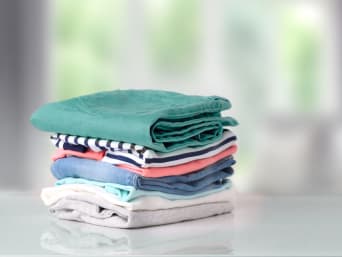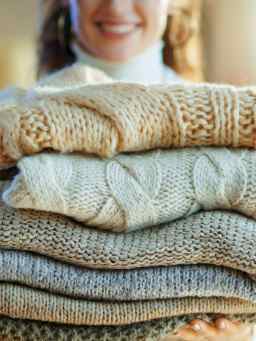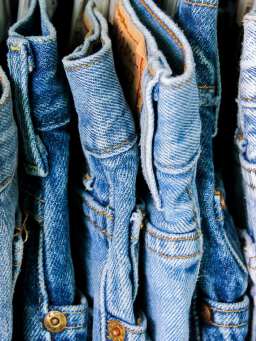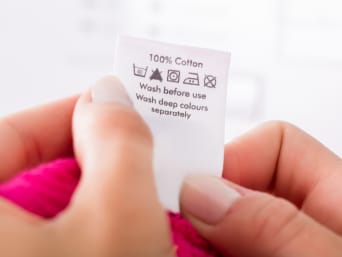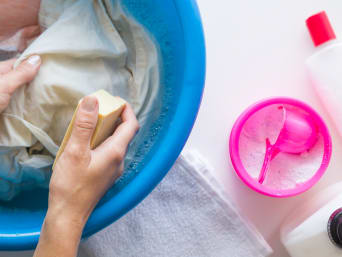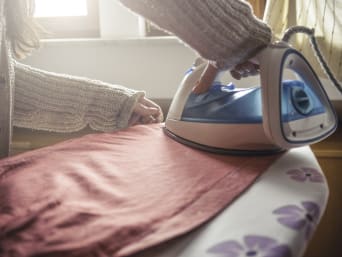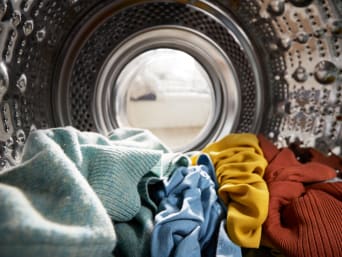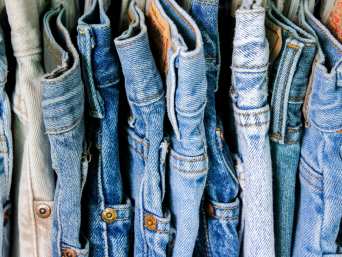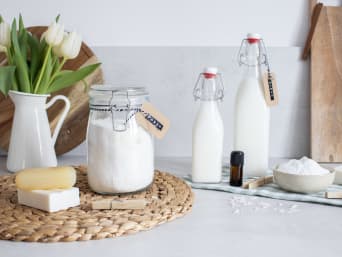How to do laundry: tips and instructions on textile care
You can get the most out of your favourite clothes by washing and drying them correctly. Before washing clothes make sure to double check at what temperature they can be washed as not all types of materials can be washed at 60°C with the same type of laundry detergent. By looking at the label you can find out what materials the garment is made of and how to wash it accordingly. By following the washing symbols on the care label you can sort your clothes into piles and this will help you to make sure that everything is washed correctly. In our guide you'll find lots of helpful tips and tricks on how to wash, dry and iron your clothes as well as how to remove stains.
Important laundry tips
Before washing your clothes make sure to have a look at the textile label. A care label will tell you how to wash clothes and what materials they are made of. Here you can also find out more about how clothes should be dried and ironed. The washing symbols will help you to sort your laundry into different piles, for example, delicates in one pile and dark colours in another pile.
We have put together a PDF with all the laundry and care symbols. You will be able to find out more about what the different symbols mean:
By separating your clothes into piles you can save yourself a lot of time and work and ensure that your clothes can be washed on the correct wash program with the right laundry detergent. Below we have put together some helpful tips to help you sort your laundry into piles:
Sort your laundry into piles: make sure that delicates are in one pile and more durable materials are in another pile. When washing delicates they will either need to be handwashed or washed on a delicates cycle.
Temperature: separate your laundry into different piles depending on the temperature it needs to be washed at. The temperature settings on a washing machine may vary depending on the model.
Sort by colour: separate white and light colours such as pastel colours and light grey into one pile and then make a separate pile for black/dark coloured laundry.
Once you have sorted your laundry into piles and pre-treated any stains, you can use the care label and materials of your laundry to determine which wash program and laundry detergent need to be used. For delicates you will need a special laundry detergent, for example, a mild laundry detergent. Outdoor clothing and sportswear may need to be washed on a specific wash program to prevent any damage to the delicate fibres. You will need to make sure you have chosen the right wash program when washing silk or wool. It is also worth double checking the care symbols when drying and ironing, as not all items of clothing can be ironed or tumble dried.
Tip: It is a good idea to sort your clothes into piles as some materials can only be ironed on a specific setting at a certain temperature. By doing so, you will be able to iron the items of clothing first which need to be ironed on a lower setting and then you can gradually work your way up by changing the setting for clothes that need to be ironed at a higher temperature. This will help to save you time as well as protect delicate materials from getting damaged.
Washing symbols explained
Pay close attention to the symbols on the care label so that you can get the most out of your favourite clothes. There are usually five basic symbols on every label that tell you how the garment should be washed, dried and ironed. In this article you will find a detailed overview of the most important laundry symbols so that you will know how to wash, dry and iron your clothes.
Removing stains and bad odours from clothes
To remove stubborn stains and odours from clothes a thorough pre-treatment is usually needed. You don't always have to use an expensive stain remover and often simple home remedies are enough to remove stains from your clothes. In this article we will discuss the most common types of stains and how you can remove them with home remedies. We will also tell you how to get rid of unpleasant odours from your clothes.
Helpful guide on washing machine programs
Modern washing machines have a range of functions and programs to ensure spotlessly clean washing. In addition, there is a suitable laundry detergent for almost every type of laundry. However, which wash program and laundry detergent are suitable for different materials? In this article we will show you which wash programs and laundry detergents you should use for different types of laundry.
Essential ironing tips
Proper textile care also includes ironing your clothes as gently as possible. Sometimes it is not so easy to iron a pleated shirt correctly or to get all the creases out. In this article we'll give you a short and concise explanation on how to iron clothes. We will also show you five essential tricks that you can use to keep your clothes crease free whilst on the go and for this you won’t even need an iron.
Guide on washing delicates
Delicate fabrics need to be cleaned and cared for differently compared to tougher everyday fabrics. This is the only way to prevent the fine fibres from getting damaged. In this article we will show you what you need to keep in mind when washing delicates so that your items of clothing made out of delicate fabrics stay looking great for longer. We also have some useful care tips for delicate materials such as silk, velvet, wool and cashmere.
How to wash knitwear
A nice warm knitted jumper is perfect for winter and most knitwear is made out of delicate materials such as wool, cashmere or mixed fabrics, which can be quite tricky to wash and care for. However, there are a few simple tips that you can follow to keep your knitwear fresh and soft for longer. In the following article we've summarised all the important information that you need to know about how to wash, store and mend your knitwear.
How to wash linen
Linen is an elegant and timeless material that is made for summer. The natural fibres make this material breathable. There are a couple of things that you need to keep in mind when washing linen so that you can get the most out of your linen clothes. In this article we have put together some helpful tips on how to wash and dry linen.
How to wash wool
Clothes made out of wool will keep you warm in cold temperatures. Wool is also a breathable material that is great on your skin and it wicks away moisture and offers a high level of comfort even when exercising outside. However, these excellent properties can get damaged by certain laundry detergents and when washed at a high temperature. In this article we will show you how to wash and dry wool so that you can get the most out of your favourite woollen clothes.
How to wash merino wool
The fine fibres in merino wool are excellent at keeping you warm and wicking away moisture. Merino wool is known for being very soft. This type of wool is used for baby clothes, sportswear and warm winterwear. Similar to virgin wool there are a few things to keep in mind when washing and drying merino wool. In this article we will show you how to wash and dry merino wool.
How to wash cashmere
Cashmere is a luxurious and very soft material that needs to be carefully washed and dried. In our article you can find out more about to how to wash and care for items of clothing made out of cashmere so that they stay luxuriously soft. We will also give you some helpful advice on how to remove stains and tips on how to prevent bobbling so that your cashmere clothes stay luxuriously soft for longer.
How to wash jeans
Denim is a strong and durable material, but it still needs to be washed and dried correctly. Jeans that contain spandex should not be washed at a high temperature or put on a spin cycle. In this article we will show you how to wash and dry jeans so that they retain their perfect fit and fabulous colours for longer.
Homemade washing powder & laundry detergent
It is important to wash your clothes properly to ensure that you can wear them for longer. You can even make your own environmentally friendly laundry detergent. In our guide we will show you how you can easily make your own washing powder and liquid laundry detergent with just a few simple ingredients.
Tips for natural laundry
Laundry care plays an important role when it comes to getting the most out of your clothes and being more nature-conscious in everyday life. Not only your choice of detergent, but also the dosage, washing temperature and size of your load are crucial. In this article, we’ll give you important tips on how you can save electricity and water by washing and drying in a more nature-conscious way.
______________________________________________
The image sources in this text are in chronological order
Cover photo: iStock.com/NYS444
1st foto in text: iStock.com/AndreyPopov
2nd foto in text: iStock.com/FotoDuets
3rd foto in text: iStock.com/Ziga Plahutar
4th foto in text: iStock.com/sestovic
5th foto in text: iStock.com/monkeybusinessimages
6th foto in text: Anton – stock.adobe.com
7th foto in text: Natalia – stock.adobe.com
8th foto in text: iStock.com/CentralITAlliance
9th foto in text: iStock.com/Ridofranz
10th foto in text: Look! – stock.adobe.com
11th foto in text: tendo23 – stock.adobe.com
12th foto in text: C&A
13th foto in text: iStock.com/Choreograph
